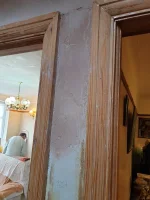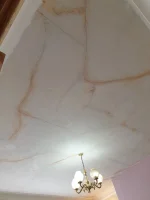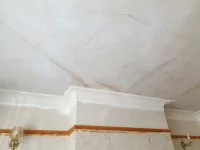Sergio_London
New Member
Greetings professionals !
I have 3 questions, if I may.
Parents house, 1930's semi. Our plasterer has completed the hallway/landing and for the best part, it looks fine [ to a layman ].
He is about to start on the living room. 'We' prepped it all, i.e. removed wallpaper from the ceiling. The ceiling looks dead straight but has cracks, quite a lot [ Photos attached ]. Our plasterer intends to use scrim tape over the cracks. My only reason for questioning this over mesh, is that with previous plasterer quotes, some suggested they would mesh. It's a bedroom above with medium traffic. I don't know if it is one of those areas where some plasterers would use mesh and others, scrim tape, i.e. a right or wrong way, just a preference? [ Photos are those which have a marble look for the ceiling ]
Second question. In the hallway, the wall between each door frame is narrow [14cm]. He has stated it is too difficult to plaster and can we buy 2 packets of Polyfilla all purpose trade polycell. I always associated Polyfilla as something you use to fill in small cracks here and there rather than using it inplace of plaster. Is he off track here?
We are removing and replacing the coving. Our plasterer did suggest that removing the coving would weaken the ceiling. In assessing what type of coving to replace it with, we immediately assumed plaster for plaster. Have noticed there are other materials on the market which are equally effective and if anything, are easier to work with, namely, duropolymer.
Again, not sure if this is a preference situation for plasterers as in a preference with working with one over another or is the end result cheap looking rather than effective?
Many thanks in advance !
I have 3 questions, if I may.
Parents house, 1930's semi. Our plasterer has completed the hallway/landing and for the best part, it looks fine [ to a layman ].
He is about to start on the living room. 'We' prepped it all, i.e. removed wallpaper from the ceiling. The ceiling looks dead straight but has cracks, quite a lot [ Photos attached ]. Our plasterer intends to use scrim tape over the cracks. My only reason for questioning this over mesh, is that with previous plasterer quotes, some suggested they would mesh. It's a bedroom above with medium traffic. I don't know if it is one of those areas where some plasterers would use mesh and others, scrim tape, i.e. a right or wrong way, just a preference? [ Photos are those which have a marble look for the ceiling ]
Second question. In the hallway, the wall between each door frame is narrow [14cm]. He has stated it is too difficult to plaster and can we buy 2 packets of Polyfilla all purpose trade polycell. I always associated Polyfilla as something you use to fill in small cracks here and there rather than using it inplace of plaster. Is he off track here?
We are removing and replacing the coving. Our plasterer did suggest that removing the coving would weaken the ceiling. In assessing what type of coving to replace it with, we immediately assumed plaster for plaster. Have noticed there are other materials on the market which are equally effective and if anything, are easier to work with, namely, duropolymer.
Again, not sure if this is a preference situation for plasterers as in a preference with working with one over another or is the end result cheap looking rather than effective?
Many thanks in advance !





